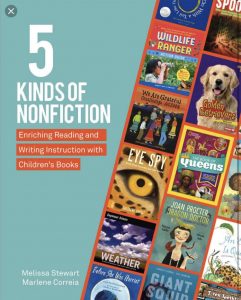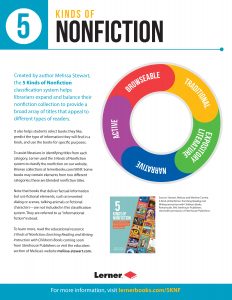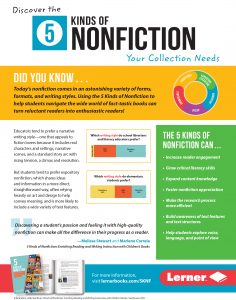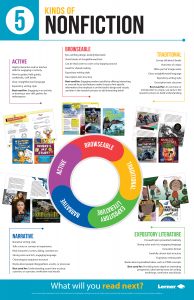Available for purchase through Lerner Books or Amazon.
In 5 Kinds of Nonfiction: Enriching Reading and Writing Instruction with Children’s Books, Melissa Stewart and Dr. Marlene Correia present a new way to sort nonfiction into five major categories and show how doing so can help teachers and librarians build stronger readers and writers. Along the way, they:
- Introduce the 5 kinds of nonfiction: Active, Browseable, Traditional, Expository Literature, and Narrative—and explore each category through discussions, classroom examples, and insights from leading children’s book authors
- Offer tips for building strong, diverse classroom texts and library collections
- Provide more than 20 activities to enhance literacy instruction
- Include innovative strategies for sharing and celebrating nonfiction with students.
With more than 150 exemplary nonfiction book recommendations and Stewart and Correia’s extensive knowledge of literacy instruction, 5 Kinds of Nonfiction will elevate your understanding of nonfiction in ways that speak specifically to the info-kids in your classrooms, but will inspire all readers and writers.
Bound to Stay Bound has curated booklists in the BTSB Bookstore within these categories. Click on a circle to be redirected to that specific booklist.
BROWSEABLE
Eye-catching design, lavishly illustrated
Short blocks of straightforward text
Can be read cover to cover or by skipping around
Great for shared reading
Expository writing style
Description text structure
Best used for: Engaging readers quickly by offering interesting or unusual facts; text features make it easy to find specific information; the emphasis is on the book’s design and visuals; use later in the research process to add interesting detail
EXPOSITORY LITERATURE
Focused topics presented creatively
Strong voice and rich, engaging language
Innovative format
Carefully chosen text structure
Expository writing style
Books about specialized ideas, such as STEM concepts
Best used for: Providing more depth or interesting perspective, ideal mentor texts for writing workshops, nonfiction read alouds
NARRATIVE
Narrative writing style
Tells a story or conveys an experience
Real characters, scenes, dialog, narrative arc
Strong voice and rich, engaging language
Chronological sequence structure
Books about people (biographies), events, or processes
Best used for: Understanding a past time or place, a person, or a process; nonfiction read alouds
Lerner has created 3 downloadable & printable pdf files.
“Enriching Reading and Writing Instruction with Children’s Book” by Marlena Correia and Melissa Stewart. Text copyright © 2021 by Melissa Stewart and Marlene Correia. Published by Stenhouse Publishers Images used with the permission of Lerner Publishing Group, Inc. and Stenhouse Publishers All rights reserved. No part of these text or images may be used or reproduced in any manner whatsoever without the prior written permission of Lerner Publishing Group, Inc.












